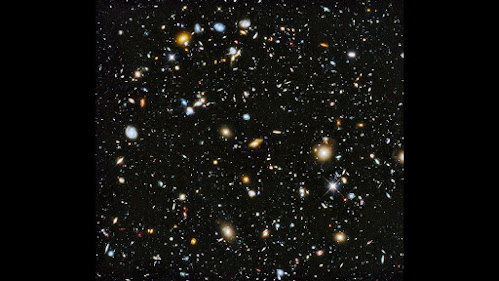The Hubble Space Telescope has been and continues to be one of humanity’s greatest scientific instruments. With it, astronomers have already made 1.6 million observations and written more than 21,000 scientific papers. It added dramatically to our knowledge of the universe. Being such a complex instrument, NASA designed it so that it could be periodically serviced, replacing parts that wear out over time. Five servicing missions visited Hubble. The most important was the very first one. It corrected a tiny mistake in the shape of its main mirror, which was off by less than the width of a human hair. The other four service missions replaced items such as batteries, gyroscopes, and electronic boxes, all of which have limited life. On some missions, astronauts installed state-of-the-art science instruments. Each service mission left Hubble a more capable and more productive observatory.
Hubble Space Telescope, credit STSCI, NASA, ESAAnd capable it is. It showed us
things astronomers never even guessed might be out there. Perhaps the most
amazing science it produced came in the form of a series of long-exposure photographs,
342 in all, with a total exposure time of over 100 hours, known as the Hubble
Deep Field. They
pointed it to an apparently empty spot near the Big Dipper, a patch of sky about the
equivalent of a pinhead at arm’s length.
Expecting to find maybe a few distant galaxies, the final combined images revealed more than 3,000 galaxies including what were at the time the most distant objects ever seen. The image amazed astronomers with the new data they obtained. That project was such a success that astronomers did another version from a spot in the southern hemisphere sky. With the success of those two images, astronomers then used Hubble to create the Ultra Deep Field image. It was a combination of 800 images taken over eleven and a half days, revealing more than 10,000 galaxies and again setting new distance records.
Hubble Ultra Deep Field, credit NASA, ESAHubble’s discoveries range far beyond simply observing thousands of galaxies in apparently empty patches of the sky. It was instrumental in discovering the existence and distribution of Dark Matter. The speed at which a planet orbits the sun depends on its distance from the sun, with planets farther out moving slower due to distance from the sun’s gravity. By the same token, stars at a galaxy’s edge should move slower than those closer in. But Hubble’s measurements showed that stars across the entire galaxy move at virtually the same speed, and move so fast that the gravity from all the matter of the galaxy couldn’t hold the galaxy together. Galaxies had to be embedded in a large shell of gravity-producing but invisible matter. Hubble was able to map the distribution of dark matter around the universe, helping to show it accounts for 85% of the matter in the universe. Using Albert Einstein's prediction that gravity can focus light, Hubble was used to take images of distant objects the light of which is focused by intervening sources of gravity. By studying these, they could measure the gravity from dark matter sources.
Hubble data measured the speed at which the universe expands, showing that the expansion is speeding up, leading to the discovery of Dark Energy. Hubble helped to verify the existence of exoplanets, those orbiting other stars. Astronomers used Hubble to study the formation and evolution of galaxies. Because of its keen vision, it helped astronomers better understand how stars change with age, the mechanics of supernovas, and the cause of short gamma-ray bursts, a subject that puzzled astronomers for many years. And this is only the tip of Hubble’s accomplishment iceberg.
We no longer have the space shuttle
that flew astronauts on all the Hubble servicing missions. Now, it only has two
functioning gyroscopes, which enable its precise pointing. Any observation it
makes from now on will take more time. Hubble’s end is certainly in sight.
The Webb Space Telescope, Hubble’s
successor, has taken the mantle as the best space telescope, but astronomers
will still mourn Hubble’s passing whenever its mission finally ends.
Each month, I write an astronomy-related column piece for
the Oklahoman newspaper. After it is
published there, I post that same column to my blog page.
This is reprinted with permission from the Oklahoman and www.Oklahoman.com.



